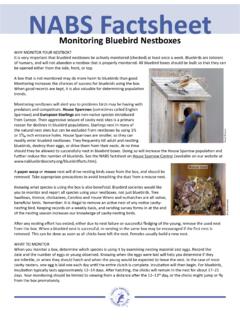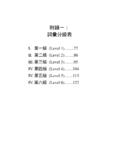Transcription of BS Factsheet - Bluebird
1 NABS Factsheet Getting Started with Bluebirds Over the years, land has been cleared for housing and commercial developments, highways and agriculture, and many old trees have been cut down. Wooden fence posts that provided nesting cavities have been replaced with metal posts. With modernization, the supply of natural nesting cavities for bluebirds and other native cavity nesters has been greatly reduced. Habitat loss was compounded by the introduction into North America of two imported species the European Starling and the House Sparrow (not to be confused with sparrows that are native to North America, such as the Song Sparrow, Tree Sparrow, etc.)
2 Both starlings and House Sparrows are cavity nesters. Both are very aggressive. House Sparrows are small enough to enter any hole that a Bluebird can, and will chase away or kill bluebirds. Starlings can be excluded from entering nestboxes boxes by using the correct size entrance hole, but will out-compete bluebirds for woodpecker holes and other natural nesting cavities. During the summer, bluebirds feed mainly on insects. In the winter, they Dave Kinneer depend on wild berries. However, the supply of wild berries has decreased over the years.
3 The few that remain are often quickly stripped by large flocks of starlings. Even though Bluebird populations have decreased, their future can still be promising. The most important step we can take to help bring back the Bluebird is to provide nesting sites by setting out a Bluebird nestbox or starting a Bluebird trail. A Bluebird trail is a series of Bluebird boxes placed along a prescribed route. In areas where nestboxes have been put up in suitable habitat, Bluebird populations are increasing. Bluebirding is a great hands-on environmental project that people of all ages can enjoy.
4 By following the instructions below, chances are good that you will be able to attract and enjoy bluebirds. THE Bluebird NESTBOX. A good Bluebird box should be well ventilated, watertight, and have drainage holes. It should be easy to open, monitor, and easy to clean. Solid, untreated wood is an ideal material, although exterior grade plywood can be used. The outside of boxes can be painted or stained if a light color is used. A Bluebird box should not have a perch. Predatory House Sparrows and House Wrens are attracted to perches.
5 Nestboxes for Eastern Bluebirds should have a round entrance hole measuring 1 ". to 19/16" in diameter, or a 1 " x 2 " vertical oval hole, or a 1 " to 13/16" horizontal slot entrance. Western and Mountain Bluebirds use a 19/16" round opening or 13/16". slot entrance. Because there are no undesirable species that can access 19/16" holes that cannot also access 1 " holes, some monitors in Eastern Bluebird territory use 19/16" holes. Although bluebirds seem to prefer oval holes, smaller European Starlings may be able to enter them, especially if they are not exactly 1 " x 2 ".
6 Nestboxes that are on the small to moderate side reduce the possibility of starling use. Bluebird nestboxes are available from NABS and most Bluebird organizations, or from commercial sources. Plans for building nestboxes are also available. Please see the NABS Factsheet , Nestbox Specifications (also online at ). MOUNTING THE Bluebird BOX. S mooth round pipe is probably the best and simplest mounting system to use " or 1" electrical conduit works well, but any Connecticut Dept. of Energy & Environmental Protection smooth scrap round pipe will also work.
7 A fencepost driver, available at hardware stores, is an excellent tool for driving conduit into the ground. Avoid mounting Bluebird boxes on a fenceline or on trees where climbing mammals or snakes are present. Periodically coating the pole with wax or food-grade grease will help to keep climbing predators away from the box. Hardware cloth, or a wobbling stovepipe (Kingston) or PVC baffle placed on the pole directly underneath the box helps prevent access by climbing predators, including snakes (see examples at right).
8 Refer to the NABS Factsheet on Predator Control ( ) for more information. SETTING UP A Bluebird TRAIL. H abitat is the key factor to consider when setting up a Bluebird trail. Open rural country with scattered trees and low or sparse ground cover is best. Suitable habitat should include a fence line, wires, tree branches, or other sites where bluebirds can perch to search for food. If bluebirds do not like the habitat, they probably will not use your nestboxes. Open pastureland, parks away from human traffic, and mowed areas such as cemeteries and golf courses are all good locations for a Bluebird trail.
9 Avoid areas of heavy pesticide use. Susan Tartaglino Mount nestboxes at least 50 200 feet away from brushy and heavily wooded areas this is the habitat of the House Wren, a native species that may destroy Bluebird eggs and/or compete with bluebirds for nestboxes. Avoid areas where the House Sparrow is abundant, such as farmsteads and feedlots, or where people feed cheap birdseed Male House containing millet and cracked corn. House Sparrows are vicious Sparrow competitors. People who successfully raise bluebirds (and other native secondary cavity nesters) in House Sparrow territory generally trap and euthanize House Sparrows that invade nestboxes, but this may be too late to save young or adult bluebirds from House Sparrow attack.
10 Luc Viatour For convenience, mount nestboxes so the entrance hole is approximately five feet (eye level) above the ground. Alternatively, a large hook can be installed on nestboxes, which can then be hung in trees by using a long pole. The Southern California Bluebird Club has had good success with this method; they are an excellent source of information. Face the nestbox away from prevailing winds, and if possible, face it toward a tree or shrub that is within 100. feet of the box to provide a landing spot for the young bluebirds when they first leave the box.












